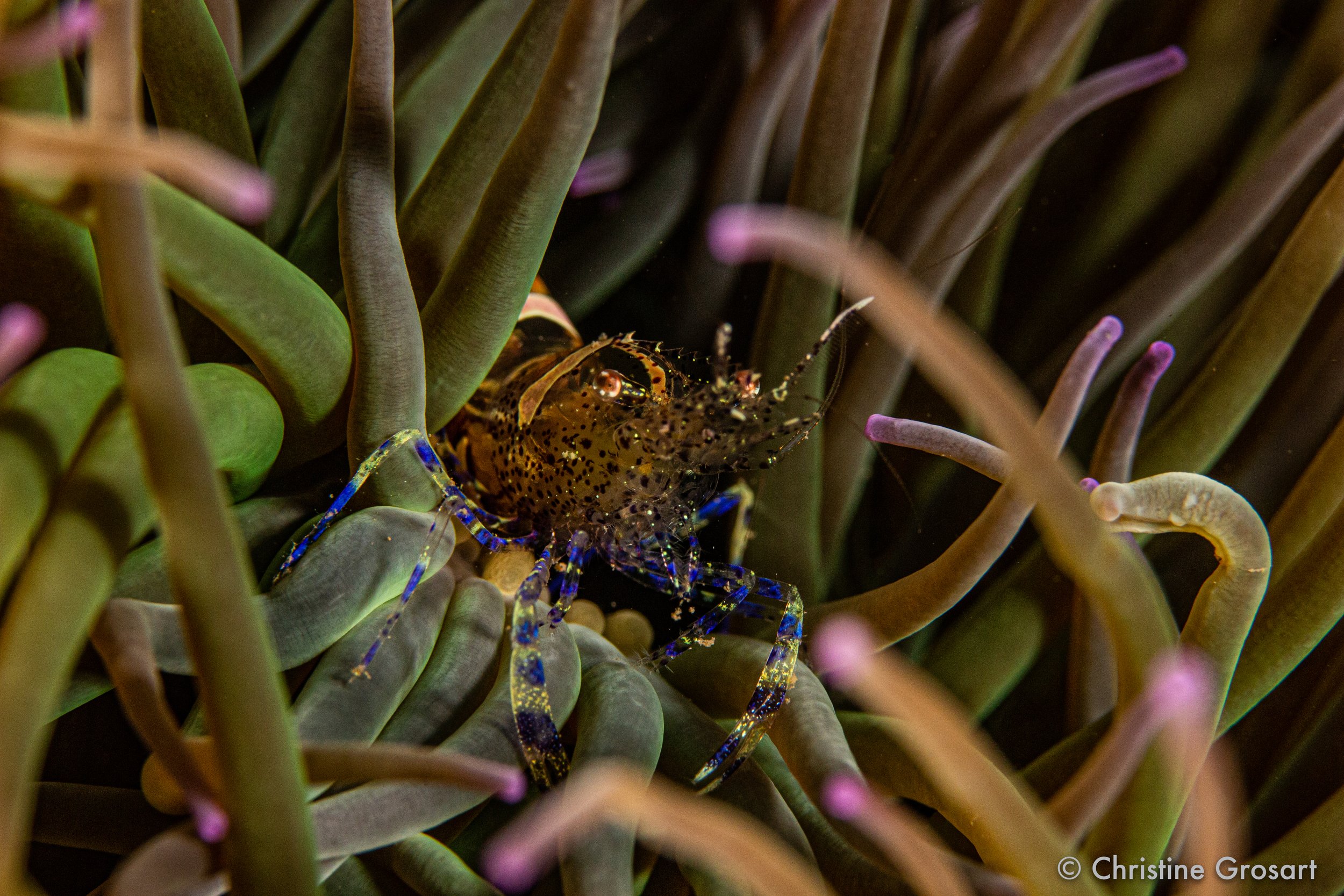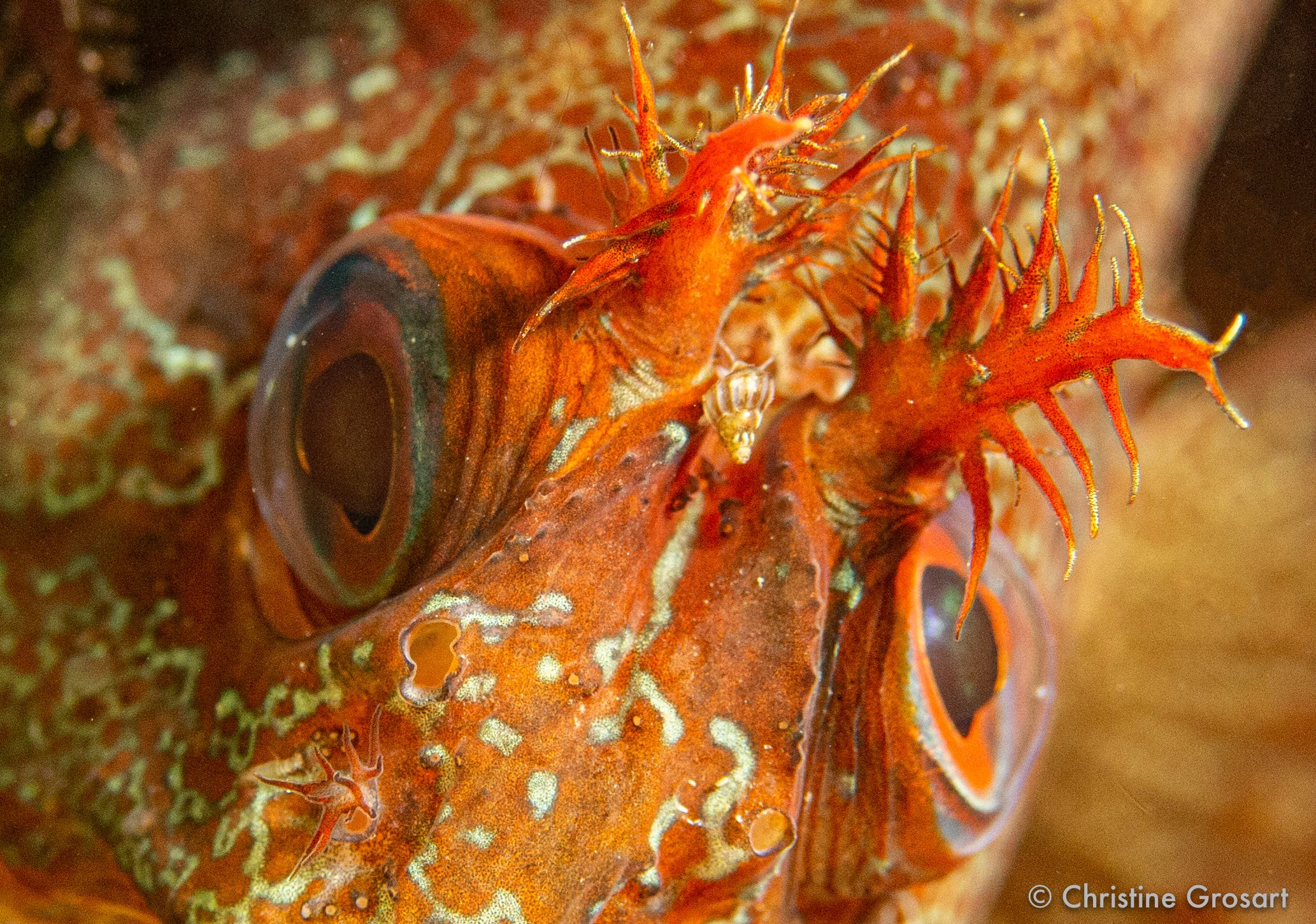Beautiful Babbacombe
Pipefish. Image: Christine Grosart
Shameful, I know...but I had never dived Babbacombe!
Either the wind was going the wrong way, the visibility too poor, too much rain, waves breaking over the wall into the car park, too many people...
The list of excuses is endless.
But finally. I had some time at home, in the UK and in SUMMER!
This never happens AND the divers from the Facebook group South Coast Divers had been putting up some cracking images of critters down at 'Babbers' as it's fondly known.
I was fortunate to be welcomed by three people I had never met before nor dived with but we all had something in common - squidge!
Squidge is a diver's slang for marine animals. As opposed to spidge, which is wreckage.
Someone once pointed out that with regard to UK wreck diving, you can get the same effect walking around your local scrapyard at night, in the fog with a rubbish torch, in the rain!
There have seldom been times when I could argue with that. Triple expansion engines don't interest me and why is everyone so obsessed about boilers?
No, despite trying to fit in with the crowd, I'm afraid I have to admit to being a 'squidge' person.
This was evident when I spent an entire dive in Scapa Flow photographing starfish on the seabed and making scallops swim - they are so funny!
That evening in the pub, someone asked me where I had dived. "Markgraf" I replied.
"Oh" he said "See any nice scallops?"
I digress.
Jewel anemones and nudibranchs. Images: Christine Grosart
Anyway, off I went down to Babbers and needed to find somewhere to doss overnight. Covid makes things tricky but I did find a prime spot where overnight parking is allowed and the morning view is to die for.
I woke to the most glorious sunrise and the waves gently lapping only yards form Agnetha.
I made myself a strong coffee and had light chit chat with passing dog walkers.
It was time to pack up and head round to Babbers to meet Tamsyn, who had volunteered to show me around. Lisa and Richard Frew from Dive South had also come along for their first time at Babbers.
I'd had some fun building a single cylinder set up as I rarely dive anything other than my twins, sidemounts or CCR. But as we were only going to about 6 metres all that seemed rather overkill.
The super-hard-to-spot Snakelock anemone shrimp. Image: Christine Grosart
The sea was sparkling, the coffee shack was open and although it was busy with families and anglers, the atmosphere was friendly and folk kept their respectful distances. For just a couple of hours, we could drop beneath the waves and leave covid behind.
After an excellent location brief by Tamsyn, we walked to the end of the jetty and were accosted by a grey seal who was obviously hanging around the anglers hoping for some fish.
He'd got too brave for his own good and was sporting a hook in his mouth. He was close enough as we put our fins on that we could smell his fishy breath.
We got in and he soon vanished.
The visibility was about 8 metres and it was great to be diving with likeminded people. I was on a mission to take some nice macro shots and so were they. I was also keen to do some Seasearch recording. I love the way that just a simple, shallow dive can contribute to citizen science and even go some way towards creating MCZs.
Pregnant variable Blenny. Image: Christine Grosart
The snotty water and kelp soon gave way to a shallow reef and this was teeming with life. The usual Tompot blennies made an appearance but apparently I photographed one special little critter without even realising it!
The Variable Blenny has apparently been absent from our waters for several years. At least, there had been no positive ID of one since around 2007.
The South Coast Divers group, many of whom were keen Seasearchers, had been doing plentiful shore diving during these covid times and Variable Blennies were seemingly back in town.
And they rather liked Babbacombe!
For those not in the know, Seasearch changed my life. Well, that may seem an exaggeration but for a cave diver who gets easily bored in the sea and disappointed on almost every dive by 'only' seeing just kelp or weed or rocks with 'stuff' on them then well yes, you can see why I got a bit disillusioned with diving in the sea.
It offered me very little challenge and I found wrecks creepy and a bit boring.
Double spiral worms. Image: Christine Grosart
Then I did a Seasearch Observer course and my whole world changed.
National Seasearch coordinator Charlotte Bolton once said to me:
"Call me sad - but I love ALL my dives".
Rubbish, I thought. You must have at least one or two crap dives.
"Nope" she said "I love all of them."
How was this even possible?
The Seasearch course opens your eyes. It makes you look, Then look again, Then look closer again and before you know it you are analysing seaweed 'feet' and arguing over the markings on a corkwing wrasse.
An octopus could be dressed in a grass skirt and playing the maracas right in front of you but you'd probably miss it because you were trying to decide what length of 'animal turf' to put on your form.
In fact, no, you wouldn't miss it. You would simply enter it as 'rare' and gloat about it on your cephalopod reports - complete with photo.
Oh, it changed my life alright and it definitely changed my diving. It gave me a new lease of life and I spent every day offshore dreaming about not only taking macro photos of cool stuff but sifting through marine critter ID books and filling out Seasearch forms in latin.
I don't know what has happened to me but I like it. Diving for a purpose rocks!
Velvet swimming crab in a snakelog anemone wig. Image: Christine Grosart
I still can't tell the difference between a crab and a wrasse but I do love pretending I can and it is quite satisfying when someone tells you that you've photographed something quite rare when a) You couldn't take a photo of a fish at all last week and b) you had no idea what you were looking at and thought they were just everywhere!
Tamsyn very kindly pointed out a pipefish to me once I'd packed my camera away. She felt bad so pointed out another one on our second dive post coffee and sandwich.
He obliged beautifully. Their snouts are so long they are a pain to get in the frame and in focus, hiding in all that weed.
Pipefish. Image: Christine Grosart
We headed for Mushroom Rock which is, no surprises, a large mushroom shaped rock right in the middle of the bay. Underneath, it is adorned with jewel anemones. These are my new favourite things to photograph. All colours, pinks, greens, purples, yellows...just stunning.
I inspected every damn snakelock anemone searching for the fashionable 'anemone shrimp'. This elusive shrimp likes to hang out in snakelocks and has kept macro photographers sane throughout covid.
I hunted religiously through every patch of snakelocks, going over and over in my head that it takes determination and hard work to get that photo you want and nothing comes easy on a plate and OH HELLO!
There he was.
I managed a few quick shots and signalled frantically to the others, at which point he turned his bum on them and hid in the most awkward place, almost impossible to photograph. I think Lisa got a few but he really was a bit camera shy.
The super-hard-to-spot Snakelock anemone shrimp. Image: Christine Grosart
Velvet Swimming Crabs like to wear snakelock anemones as wigs and they made for some amusing photographs.
I had a fantastic day with such lovely people and definitely got my photography and Seasearch fix.
I'm chuffed to bits with several recent purchases. My Ikelite housing was bought to accommodate my Canon 100D DSLR camera and I bought some second hand Ikelite strobes, DS160 and DS161.
I was debating for a while about a Cinebag Grouper, which seemed like a nice idea but quite pricey for what I thought was just a cooler bag with a badge.
I took a punt and bought one.
How wrong I was. The bag is sturdy, well padded and well thought out, with waterproof inner zip pockets and it is heavy duty. I keep an old sofnolime can full of fresh water in my car and you can use the Cinebag as a rinse bucket.
It takes up little space in my car and protects my equipment on the boats. I love it.
Blenny. Image: Christine Grosart
Lobster. Image: Christine Grosart
Tompot Blenny. Image: Christine Grosart
Pipefish. Image: Christine Grosart













